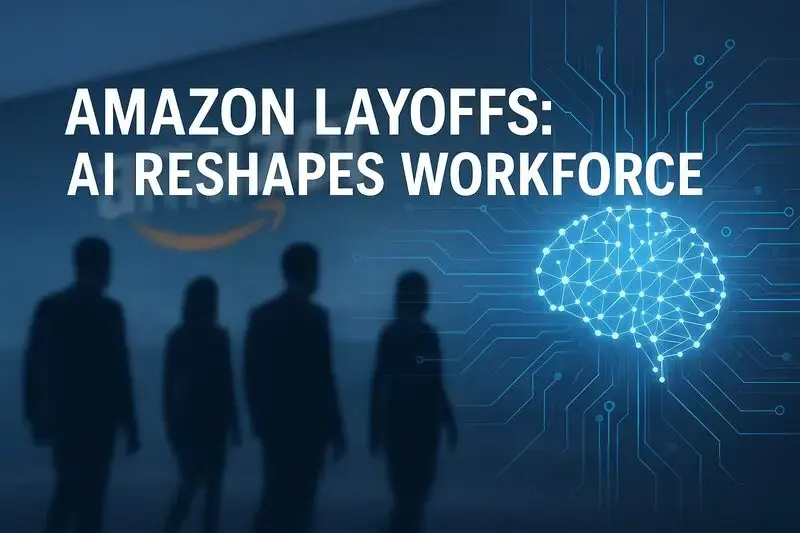Amazon is preparing to cut up to 15% of its human resources staff right now as part of a major AI-driven restructuring that’s hitting multiple departments. The company’s People eXperience and Technology team will experience the deepest reductions, though job losses will spread across other consumer business units too.
Amazon hasn’t disclosed the total number of positions the company plans to eliminate yet, and the exact timing remains unclear at the time of writing. These cuts follow smaller rounds of job losses earlier this year in the consumer devices group, the Wondery podcast division, and also Amazon Web Services. But this wave differs—it represents a fundamental shift in how Amazon manages its workforce as the company goes all-in on artificial intelligence and automation.
AI Spending And Job Cuts Go Hand In Hand

Amazon is pouring over $100 billion this year into capital expenditures, with a huge portion of that money going toward building advanced data centers. The company designed these facilities to power AI infrastructure for both Amazon’s internal operations and enterprise clients who need cloud computing capabilities.
CEO Andy Jassy laid out the company’s vision in a memo sent to employees back in June, and he didn’t mince words about what this transition means for workers:
“Those who embrace this change, become conversant in AI, help us build and improve our AI capabilities internally and deliver for customers, will be well-positioned to have high impact and help us reinvent the company.”
Jassy also made it clear that increased efficiency through AI would lead to a smaller corporate workforce—essentially warning employees that not everyone would make it through this transformation.
Also Read: Microsoft (MSFT) Bets $33B on CoreWeave & Nebius to Ease AI Crunch
Not The First Round Of Cuts Under Jassy
Amazon already went through its largest-ever reduction between 2022 and 2023, when the company eliminated approximately 27,000 corporate positions under Jassy’s leadership. Post-pandemic overexpansion and changing consumer behavior drove those earlier cuts as people shifted back to pre-COVID shopping patterns.
The current round is more strategic in nature. Amazon is actively transitioning toward AI-driven operations, and that means rethinking what the white-collar workforce should look like going forward. Jassy has built a reputation as a cost disciplinarian, encouraging teams to pursue what he calls “unregretted attrition“—a term that means Amazon is comfortable when certain employees leave through resignations or managed exits.
But insiders say these upcoming reductions differ from routine attrition cycles. Amazon is restructuring the PXT division from the ground up as the company prioritizes efficiency and AI integration, signaling a permanent change in how it operates rather than temporary adjustments.
Hiring Warehouse Workers While Cutting Office Jobs
Here’s where things get interesting: even when the Amazon is intending to decrease the number of white-collar workers, the company has recently announced that it is hiring 250,000 temporary employees at the US warehouses and logistics networks during the next holiday season. This comparison demonstrates how AI and automation are having dissimilarly strong impacts on various categories of workers.
Automated systems and AI tools are replacing office jobs that involve data analysis, HR functions and administration. Meanwhile, warehouses still need physical workers to handle the flood of orders during peak shopping times—at least for now. The contrast shows that Amazon follows a dual approach: automate corporate processes using technology while continuing to rely on human hands to deliver and fulfill distribution needs.
Also Read: Wall Street Journal Projects Amazon Stock To Generate 42% Gains (AMZN)
A Preview Of What’s Coming For Other Companies
The transformation of Amazon is probably an epitome of what other technology companies and large corporations will encounter in the foreseeable future. With an increasing ability of AI systems to perform tasks that were previously performed by well-trained professionals, business owners will have to make difficult decisions concerning the structure of their workforce and the roles that will not be replaced.
The message to workers in the affected departments is simple: quickly adapt to an AI-driven workplace or face getting left behind. The reorganization raises the question of how employees who can’t or won’t keep up with the speed of transition will fit within the vision Amazon is creating moving forward—and whether similar scenarios will play out in the wider business context as automation increases.






